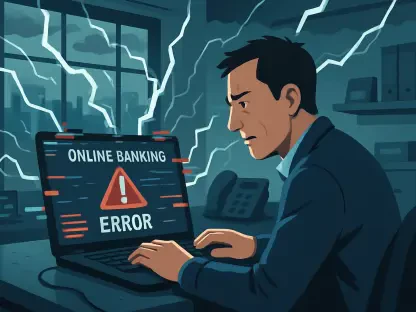The banking sector is increasingly reliant on third-party vendors for various functions and services. While this outsourcing can drive operational efficiency, it also exposes banks to a myriad of third-party risks. As these partnerships grow in complexity, robust third-party risk management has become crucial. Managing these risks is especially critical as regulatory bodies intensify scrutiny and the potential for operational disruption and cyber threats escalates.
Understanding Third-Party Risks
Types of Third-Party Risks
Third-party risks come in various forms, affecting banks in multiple ways. Operational risks arise when external vendors fail to deliver critical services, disrupting daily operations. Cybersecurity risks are ever-present, especially regarding data breaches and cyberattacks targeting vendors. Compliance and legal risks also emerge if vendors do not adhere to regulatory standards. With the increase in digital banking functions, the risks associated with third-party vendors have multiplied, demanding an all-encompassing risk management approach.
Effectively managing these risks requires banks to implement stringent third-party oversight frameworks. By monitoring third-party activities, banks can preemptively address potential issues before they escalate. This involves setting up robust protocols for evaluating, selecting, and monitoring vendors. Additionally, it is crucial to ensure that these vendors uphold the bank’s standards for data protection and operational efficiency. Continuous assessment and vigilance are necessary to mitigate against any form of third-party-induced complications effectively.
Regulatory Pressure
Regulatory bodies, such as the Office of the Comptroller of the Currency (OCC) and the Federal Reserve, have heightened their focus on third-party risk management. These regulators mandate banks to establish comprehensive vendor management programs encompassing clear policies for evaluating, monitoring, and managing third-party relationships. The Consumer Financial Protection Bureau (CFPB) also underscores the importance of stringent third-party oversight in maintaining customer data integrity and regulatory compliance.
Increased regulatory scrutiny has compelled banks to adopt more stringent risk management practices. Non-compliance can result in severe penalties, making it imperative for banks to align with regulatory expectations. For instance, failing to meet these rigorous standards can attract significant fines and legal repercussions, which can tarnish a bank’s reputation. Consequently, banks are investing heavily in ensuring that their third-party risk management practices are not only compliant but also robust enough to tackle future regulatory challenges.
Key Strategies for Effective Risk Management
Conducting Comprehensive Due Diligence
Before onboarding any third-party vendor, performing thorough due diligence is essential. This involves assessing the vendor’s operational capabilities, financial stability, and adherence to regulatory requirements. A meticulous due diligence process ensures that banks partner only with reliable and compliant vendors who meet their stringent operational standards. The process often includes a detailed review of a vendor’s business practices, past performance, and compliance history.
Contractual agreements must be clearly defined to allocate liability and outline responsibilities. These agreements serve as a safeguard, protecting banks from potential risks associated with third-party operations. They should include clauses for audits, data protection, and termination rights to shield the bank from any breaches or non-compliance issues. By establishing rigorous contracting processes, banks create a strong legal framework to manage and mitigate third-party risks effectively.
Continuous Monitoring and Business Continuity
Ongoing monitoring of high-risk vendors is crucial to ensure they comply with contractual obligations and risk standards. Continuous oversight allows banks to detect issues proactively and implement corrective actions before any significant damage occurs. Ensuring that vendors adhere to agreed-upon performance metrics and compliance requirements is vital for maintaining operational stability. Building a robust vendor management program that includes regular audits and performance reviews can help banks uphold these standards.
Developing robust business continuity plans is another key strategy. These plans should address potential third-party failures, ensuring banks can respond swiftly and effectively to any disruptions. Business continuity plans are essential for maintaining operational resilience and customer trust. They should include backup strategies and alternative vendors to mitigate any adverse effects of vendor failure. This preparation is vital for ensuring that services remain uninterrupted, even in the face of third-party operational disruptions.
Leveraging Technological Solutions
Risk Management Software
Many banks are turning to risk management software to streamline the oversight of third-party risks. These tools help reduce the operational, financial, and administrative burdens of monitoring vendors. By tracking performance metrics, compliance status, and risk indicators, these systems provide banks with a comprehensive view of their third-party risk landscape. Risk management software also enhances efficiency by automating many routine tasks associated with vendor oversight, allowing risk managers to focus on more critical issues.
Despite the benefits, the complexity of managing third-party risks continues to grow. As banks increasingly outsource critical functions such as technology and customer services, they must adopt more sophisticated tools and methodologies to manage these intricate relationships. These advanced tools can help banks stay ahead of potential issues and maintain their third-party risk exposure within acceptable limits. Integrating such technologies into the broader risk management framework is necessary for handling the multi-faceted nature of these risks.
Cybersecurity Measures
Assessing the cybersecurity practices of third-party vendors is a significant part of due diligence. Ensuring data protection measures like encryption, access controls, and secure data storage is paramount. The banking sector faces heightened cyber threats that require robust mitigation strategies. By thoroughly evaluating a vendor’s cybersecurity protocols, banks can ensure that sensitive information remains protected against unauthorized access or breaches.
Banks must establish clear protocols and processes to assess and monitor the cybersecurity practices of their third-party vendors, mitigating potential threats to their data integrity. Regular cybersecurity audits and assessments should be part of the continuous monitoring process. Establishing clear incident response plans for potential cyber threats involving third-party vendors also helps in mitigating risks. Staying current with emerging cyber threats and adapting practices to combat these effectively ensures both the bank’s and the vendor’s resilience against cybersecurity challenges.
Adapting to Evolving Regulatory and Global Dynamics
Enhancing Due Diligence for International Vendors
Globalization introduces cross-border risks, new regulatory challenges, and cultural differences. When dealing with international third-party vendors, enhanced due diligence is necessary. This additional scrutiny helps banks navigate the complexities associated with cross-border partnerships and mitigates any additional risks. A thorough understanding of international regulatory environments and compliance standards is essential for maintaining global partnerships without jeopardizing the bank’s operational and regulatory integrity.
By adapting their risk management practices to meet global standards, banks can effectively manage international third-party relationships and ensure compliance with various regulatory requirements. Leveraging local expertise and resources can aid in understanding and responding to the unique risks associated with international collaborations. This level of preparation and due diligence is crucial for the seamless management of cross-border operations and partnerships.
Flexible Risk Management Approach
Evolving regulatory expectations necessitate a flexible and adaptive approach to third-party risk management. Banks must continuously update their policies and procedures to align with new regulatory requirements. This proactive approach helps banks stay ahead of regulatory changes and ensures ongoing compliance. Flexibility in adapting to new regulations and the ability to pivot quickly in response to regulatory updates are imperative for maintaining a compliant and efficient third-party risk management program.
Establishing a culture of continuous improvement within the risk management framework enables banks to anticipate and respond to regulatory changes effectively. Integrating advanced risk assessment tools and methodologies ensures that banks can navigate the complexities of an ever-evolving regulatory landscape. Regular training and awareness programs can also help banks stay informed and prepared to meet emerging regulatory challenges.
Best Practices for Managing Third-Party Risks
Establishing a Governance Structure
A clear governance structure is essential for managing third-party risks effectively. Many banks have implemented vendor management offices or practices to oversee third-party relationships. This centralized governance ensures that roles and responsibilities are clearly defined and that third-party risk management is integrated into the broader enterprise risk framework. Establishing a dedicated team for vendor management strengthens oversight and ensures a systematic approach to identifying and mitigating potential risks.
Governance structures often include detailed policies for vendor selection, performance monitoring, and risk assessment. These policies guide the risk management team in maintaining a consistent and thorough approach to third-party oversight. Moreover, a well-structured governance model facilitates better communication and coordination among different departments, enhancing the overall effectiveness of the third-party risk management framework.
Employee Training and Awareness
Ongoing training and awareness programs for employees, especially those directly involved in managing third-party relationships, are critical. Staff must understand the importance of mitigating third-party risks and possess the necessary skills to manage these relationships effectively. Regular training helps employees stay updated on evolving best practices and emerging threats, ensuring that they can handle their responsibilities efficiently.
Regular training sessions help keep employees updated on best practices and emerging trends in third-party risk management, ensuring a well-informed and proactive workforce. Training programs often include workshops, seminars, and online courses focused on risk assessment, regulatory compliance, and cybersecurity. By investing in employee education, banks can build a knowledgeable and vigilant workforce capable of effectively managing third-party risks. This proactive approach enhances the overall risk posture of the organization.
Integration with Enterprise Risk Framework
The banking sector is increasingly dependent on third-party vendors for various services and functions, aiming for improved operational efficiency. However, this outsourcing trend brings a slew of third-party risks that banks must manage diligently. As these vendor relationships become more intricate, the importance of strong third-party risk management has soared. This level of oversight is especially crucial in today’s environment, where regulatory bodies are intensifying their scrutiny and the likelihood of operational disruptions, along with cyber threats, is on the rise. Banks need to implement rigorous risk management frameworks to mitigate potential hazards that could impact their operations and reputation. By doing so, they not only comply with regulatory requirements but also protect their own interests and those of their customers. In summary, while outsourcing offers considerable benefits, the associated risks necessitate a careful and proactive approach to risk management to ensure the stability and security of banking operations.









